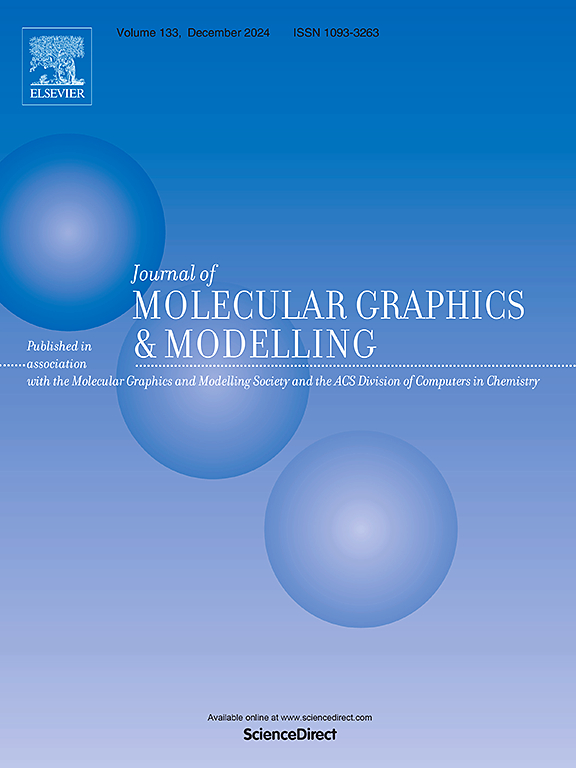1,4-对苯二酚、4-羟基苯胺、N,N'-二苯基-1,4-苯基二胺及其苯氧基和氨基基自由基的O-H/N- h键离解能。
IF 2.7
4区 生物学
Q2 BIOCHEMICAL RESEARCH METHODS
引用次数: 0
摘要
用量子化学计算方法测定了对苯二酚(H2Q)、4-氨基酚(AP)、1,4-苯基二胺(PDA)、4-羟基二苯胺(HDPA)、N,N′-二苯基-1,4-苯基二胺(DPPDA)及其苯氧基/氨基基自由基的气相键解离能(BDE) O-H/N- h。该技术包括一系列DFT (PBE1PBE, TPSSTPSS, M06-2X),价序为3ξ基集的从头算(DLPNO-CCSD(T))方法,高斯族(G4)和从头算Brueckner double (W1BD)的Weizmann理论复合方法,以及不同结构相似性水平的参考反应。采用W1BD法结合等测反应对化合物的BDE进行估算(kJ∙mol-1),其中只有一个芳香片段:BDEO-H = 352.3 (H2Q), 340.0 (AP), BDEN-H = 371.2 (AP), 364.1 (PDA) -;BDEO-H = 230.4 (H2Q), 228.8 (AP), BDEN-H = 260.0 (AP), 257.1 (PDA) -。将这些值进一步应用于HDPA和DPPDA在同流速参考过程和资源消耗较少的重新计算方法中的bde:分子BDEO-H = 341.4 (HDPA), BDEN-H = 352.9 (HDPA), 351.3 (DPPDA);自由基BDEO-H = 237.4 (HDPA), BDEN-H = 247.4 (HDPA), 252.6 (DPPDA)。DFT方法给出了类似的结果,但计算的标准误差略大。将所得BDE值(O-H/N-H)与文献数据进行比较;讨论了溶剂化对BDEs的影响。本文章由计算机程序翻译,如有差异,请以英文原文为准。

O-H/N-H bond dissociation energies in 1,4-hydroquinone, 4-hydroxydiphenylamine, N,N′-diphenyl-1,4-phenylenediamine, and their phenoxyl and aminyl radicals
Gas phase bond dissociation energies (BDE) O-H/N-H in hydroquinone (H2Q), 4-aminophenol (AP), 1,4-phenylenediamine (PDA), 4-hydroxydiphenylamine (HDPA), N,N′-diphenyl-1,4-phenylenediamine (DPPDA) as well as in their phenoxyl/aminyl radicals have been determined using a combined technique of quantum chemical calculation. The technique included a series of DFT (PBE1PBE, TPSSTPSS, M06-2X), ab initio (DLPNO-CCSD(T)) methods with valence 3ξ-basis sets, composite methods of Gaussian family (G4) and Weizmann theory with ab initio Brueckner Doubles (W1BD), as well as reference reactions of different levels of structural similarity. W1BD method was used in combination with isodesmic reactions for BDE estimation (kJ∙mol−1) of compounds with the only aromatic fragment: BDEO-H = 352.3 (H2Q), 340.0 (AP), BDEN-H = 371.2 (AP), 364.1 (PDA) – in molecules; and BDEO-H = 230.4 (H2Q), 228.8 (AP), BDEN-H = 260.0 (AP), 257.1 (PDA) – in corresponding radicals. These values were further applied to estimate the BDEs in HDPA and DPPDA within the homodesmotic reference process and less resource-intensive ab initio methods: BDEO-H = 341.4 (HDPA), BDEN-H = 352.9 (HDPA), 351.3 (DPPDA) for molecules; BDEO-H = 237.4 (HDPA), BDEN-H = 247.4 (HDPA), 252.6 (DPPDA) for radicals. DFT methods give similar results but a slightly larger standard error of calculation. The found values of BDE(O-H/N-H) are compared with literature data; the effect of solvation on BDEs is discussed.
求助全文
通过发布文献求助,成功后即可免费获取论文全文。
去求助
来源期刊

Journal of molecular graphics & modelling
生物-计算机:跨学科应用
CiteScore
5.50
自引率
6.90%
发文量
216
审稿时长
35 days
期刊介绍:
The Journal of Molecular Graphics and Modelling is devoted to the publication of papers on the uses of computers in theoretical investigations of molecular structure, function, interaction, and design. The scope of the journal includes all aspects of molecular modeling and computational chemistry, including, for instance, the study of molecular shape and properties, molecular simulations, protein and polymer engineering, drug design, materials design, structure-activity and structure-property relationships, database mining, and compound library design.
As a primary research journal, JMGM seeks to bring new knowledge to the attention of our readers. As such, submissions to the journal need to not only report results, but must draw conclusions and explore implications of the work presented. Authors are strongly encouraged to bear this in mind when preparing manuscripts. Routine applications of standard modelling approaches, providing only very limited new scientific insight, will not meet our criteria for publication. Reproducibility of reported calculations is an important issue. Wherever possible, we urge authors to enhance their papers with Supplementary Data, for example, in QSAR studies machine-readable versions of molecular datasets or in the development of new force-field parameters versions of the topology and force field parameter files. Routine applications of existing methods that do not lead to genuinely new insight will not be considered.
 求助内容:
求助内容: 应助结果提醒方式:
应助结果提醒方式:


